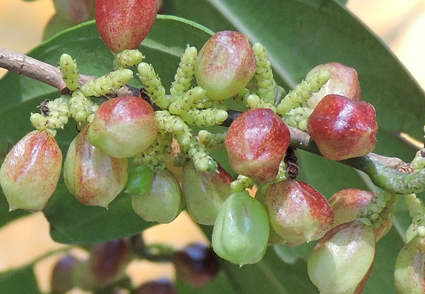Abstract
The Flora Neotropica treatment of Flaucourtiaceae s.l., by Sleumer, was a milestone in the study of the group and, consequently, of the families that were subsequently segregated from Flaucourtiaceae. Of these, Lacistemataceae comprise 16 tree-shrub species that usually occur in humid forests. However, specimens from campos rupestres in Bahia State, Brazil, were not analyzed by Sleumer so some morphological variation remained unnoticed. Here, we describe Lacistema ligiae, a new species from the campos rupestres of Bahia, and include notes on leaf venation and pollen morphology of related species. Lacistema ligiae can be recognized by leaf blades with sinuous secondary veins, which are covered by long and adpressed trichomes abaxially, hairy filament and ovary, and a distinct style not exceeding the height of the stamen.
References
<p>Bergius, P.J. (1772) <em>Acta Helvetica, Physico-Mathematico-Anatomico-Botanico-Medica, Volumen VII</em>. Joh. Rodolphi Im-Hof et Filii, Basileia, 208 pp.</p>
<p>Caldas, F.J. (1810) <em>Continuacion del</em> <em>Semanario del Nuevo Reino de Granada, memoria III – Sobre el modo de cultivar La Cochonilla</em>. La Imprensa Real de Santafé de Bogotá, 31 pp.</p>
<p>Chase, M.W., Zmarzty, S., Lledó, M.D., Wurdack, K.J., Swensen, S.M. & Fay, M.F. (2002) When in doubt, put it in Flacourtiaceae: a molecular phylogenetic analysis based on plastid <em>rbcL </em>DNA sequences. <em>Kew Bulletin</em> 57: 141–181. https://doi.org/10.2307/4110825</p>
<p>Chirtoiu, M. (1918) Observations sur les <em>Lacistema</em> et la situation systématique de ce genre.<em> In: </em>Chodat, R. (Ed.) <em>Bulletin de la Societe Botanique de Geneve, 2me serie, volume 10.</em> H. Georg & Co., Bale & Lyon, pp. 317–349.</p>
<p>Cronquist, A.<strong> (</strong>1988) <em>The Evolution and Classification of Flowering Plants</em>. New York Botanical Garden and Allen Press, New York e Lawrence.</p>
<p>Davis, C.C., Webb, C.O., Wurdack, K.J., Jaramillo, C.A. & Donoghue, M.J. (2005) Explosive radiation of Malpighiales supports a Mid-Cretaceous origin of modern tropical rain forests. <em>The American Naturalist</em> 165: E36–E65. https://doi.org/10.1086/428296</p>
<p>De Candolle, A.P. (1824) <em>Prodromus Systematis Naturalis Regni Vegetabilis, pars prima.</em> Sumptibus Sociorum Treuttel et Würtz, venitque in eorundem bibliopoliis Argentorati et Londini, Paris, 746 pp.</p>
<p>Ellis, B., Daly, D., Hickey, L.J., Johnson, K.R., Mitchell, J., Wilf, P. & Wing, S.L. (2009) <em>Manual of Leaf Architecture</em>. Cornell University Press, Ithaca, 190 pp.</p>
<p>Erdtman, G. (1960) The acetolysis method. A revised description. <em>Svensk Botanisk Tidskrift</em> 39: 561–564.</p>
<p>Exell, A.W.W. & Mendonça, F.A. (1951) Ranunculaceae-Aquifoliaceae.<em> In: </em>Wittinich-Corrisso, L. (Ed.) <em>Conspectus Florae Angolensis</em>, vol. 1. Ministério do Ultramar, Junta de INvestigações Coloniais, Lisboa, 422 pp. https://doi.org/10.2307/1216558</p>
<p>IUCN (2012) IUCN Red List categories and criteria: version 3.1, 2<sup>nd</sup> ed. Gland, Switzerland and Cambridge, UK. Available from: http://www.iucnredlist.org/technical-documents/categories-and-criteria (accessed 17 May 2021).</p>
<p>Korotkova, N., Schneider, J.V., Quandt, D., Worberg, A., Zizka, G. & Borsch, T. (2009) Phylogeny of the eudicot order Malpighiales - analysis of a recalcitrant clade with sequences of the <em>pet</em>D group II intron. <em>Plant Systematics and Evolution</em> 282: 201–228. https://doi.org/10.1007/s00606-008-0099-7</p>
<p>Leal, A., Berrío, J.C., Raimúndez, E. & Bilbao, B. (2011) A pollen atlas of premontane woody and herbaceous communities from the upland savannas of Guayana, Venezuela. <em>Palynology</em> 35: 226–266. https://doi.org/10.1080/01916122.2011.603909</p>
<p>Lorente, F.L., Buso Junior, A.A., Oliveira, P.E. & Pessenda, L.C.R. (2017) <em>Atlas palinológico: laboratório 14C-Cena/USP</em>. FEALQ, Piracicaba, 333 pp.</p>
<p>Marinho, L.C. & Amorim, A.M. (2015) Flora da Bahia: Lacistemataceae. <em>Sitientibus série Ciências Biológicas</em> 15: 1–6. https://doi.org/10.13102/scb478</p>
<p>Marquete, R. & Medeiros, E.V.S.S. (2021) Lacistemataceae. <em>In: Flora do Brasil 2020.</em> Jardim Botânico do Rio de Janeiro. Available from: http://reflora.jbrj.gov.br/reflora/floradobrasil/FB17844 (accessed 17 May 2021)</p>
<p>Martius, C.F.P. (1824) <em>Nova Genera et Species Plantarum, Volumen Primum</em>. Typis Lindaueri, Munich, 158 pp.</p>
<p>Mirbel, C.F.B. (1815) <em>Eléments de physiologie végétale et de botanique, Partie 2</em>. Chez Magimel, Paris.</p>
<p>Neill, D.A. & Asanza, M. (2012) <em>Lozania nunkui </em>(Lacistemataceae), a new species from the sandstone plateaus of the Cordillera del Cóndor in Ecuador and Peru. <em>Novon</em> 22: 207–211. https://doi.org/10.3417/2009021</p>
<p>Punt, W., Hoen, P.P., Blackmore, S., Nilsson, S. & Le Thomas, A. (2007) Glossary of pollen and spores terminology. <em>Review of Palaeobotany and Palynology</em> 143: 1–81. https://doi.org/10.1016/j.revpalbo.2006.06.008</p>
<p>Radford, A.E., Dickison, W.C., Massey, J.R. & Bell, C.R. (1974) <em>Vascular Plant Systematics.</em> Harper & Row Publishers, New York, 891 pp.</p>
<p>Rusby, H.H. (1907) <em>An enumeration of the plants collected in Bolivia by Miguel Bang. Part. 4. With descriptions of news genera and species</em>. Bulletin of The New York Botanical Garden, Volume IV, n°14. The New York Botanical Garden, New York, pp. 309–479.</p>
<p>Schnizlein, A.C.F.H.C. (1857) Lacistemataceae.<em> In: </em>Martius, C.F.P. (Ed.) <em>Flora Brasiliensis, vol. 4 (1). </em>Frid. Fleischer, Leipzig, pp. 278–288.</p>
<p>Shorthouse, D.P. (2010) <em>SimpleMappr, an online tool to produce publication-quality point maps</em>. Available from: http://www.simplemappr.net (accessed 17 May 2021).</p>
<p>Sleumer, H.O. (1980) Flacourtiaceae. <em>In: Flora Neotropica Monographs, Volume 22.</em> The New York Botanical Garden, New York, 499 pp.</p>
<p>Swartz, O. (1788) <em>Nova Genera et Species Plantarum seu Prodromus</em> <em>1</em>. In Bibliopoliis Acad. M. Swederi, Holmiae, Upsaliae & Aboae, 158 pp.</p>
<p>Thiers, B. (2021 [continuously updated]) Index Herbariorum: A global directory of public herbaria and associated staff. New York Botanical Garden’s Virtual Herbarium. Available from: http://sweetgum.nybg.org/ih/ (accessed 17 May 2021)</p>
<p>Torres, R.B. & Ramos, E. (2005) Lacistemataceae. <em>In:</em> Wanderley, M.G.L., Shepherd, G.J., Melhem, T. & Giulietti, A.M. (Eds.) <em>Flora Fanerogâmica do Estado de São Paulo, Volume 4.</em> FAPESP & Rima, São Paulo, pp. 231–237.</p>
<p>Xi, Z., Ruhfel, B.R., Schaefer, H., Amorim, A.M., Sugumaran, M., Wurdack, K.J., Endress, P.K., Matthews, M.L., Stevens, P.F., Mathews, S. & Davis, C.C. (2012) Phylogenomics and a posteriori data partitioning resolve the Cretaceous Angiosperm radiation Malpighiales. <em>Proceedings of the National Academy of Sciences of the United States of America </em>109: 17519–17524. https://doi.org/10.1073/pnas.1205818109</p>
<p>Ybert, J.-P., Carvalho, M.A. & Scheel-Ybert, R. (2017) <em>Grãos de pólen de plantas vasculares do estado do Rio de Janeiro, Brasil, Volume II</em>. Museu Nacional, Universidade Federal do Rio de Janeiro: Rio de Janeiro, 289 pp.</p>


